Umnugovi Screening Report – August 2025
8/30/2025
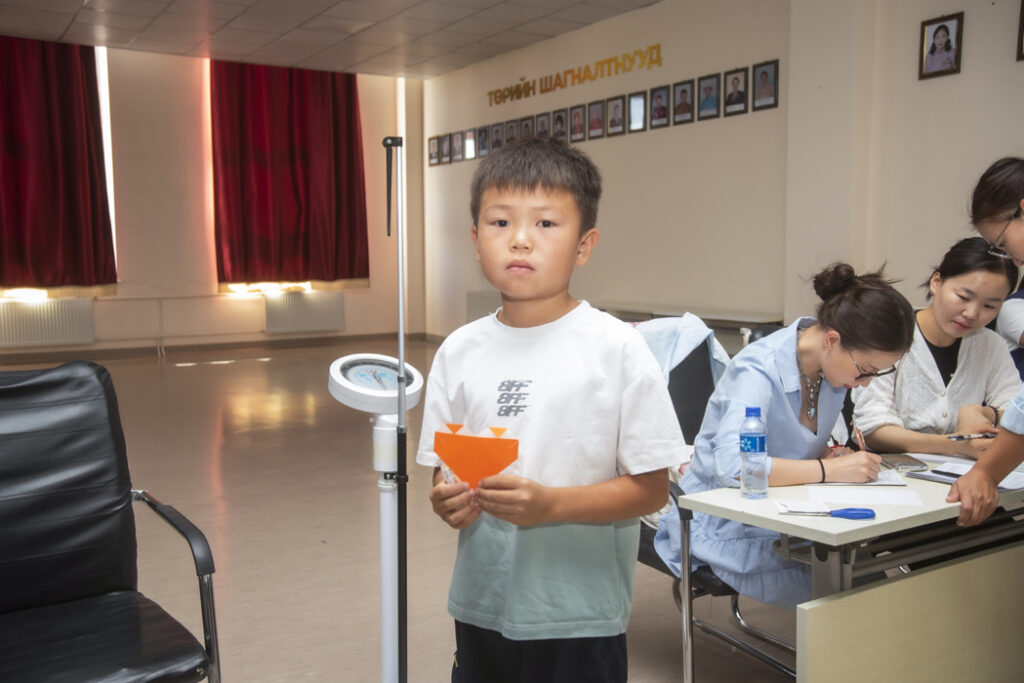 The second regional screening mission of the year in Mongolia was carried out from August 7 to 11, 2025. The destination was Umnugovi Province (provincial capital: Dalanzadgad). We had previously visited this province in 2011, making this our second visit. At the same time, the second catheterization team was working at the National Center for Maternal and Child Health (NCMCH) in Ulaanbaatar, but this report covers only the activities of the regional screening team.
The second regional screening mission of the year in Mongolia was carried out from August 7 to 11, 2025. The destination was Umnugovi Province (provincial capital: Dalanzadgad). We had previously visited this province in 2011, making this our second visit. At the same time, the second catheterization team was working at the National Center for Maternal and Child Health (NCMCH) in Ulaanbaatar, but this report covers only the activities of the regional screening team.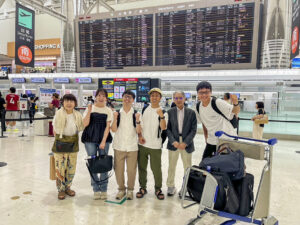
Schedule
- August 7 (Thu): Departed Narita in the afternoon on MIAT Mongolian Airlines, arrived in Ulaanbaatar at night. Overnight stay in Ulaanbaatar.
- August 8 (Fri): Departed Ulaanbaatar early in the morning. Traveled approximately 560 km by car to Umnugovi. Arrived at Sharav Memorial Regional Medical Center in Dalanzadgad around noon. After lunch, screening began in the afternoon.
- August 9 (Sat): Full day of screening.
- August 10 (Sun): Morning screening followed by a conference. Departed the site after lunch, arrived in Ulaanbaatar in the evening.
August 11 (Mon): Departed Ulaanbaatar in the morning on MIAT Mongolian Airlines, arrived at Narita in the afternoon. Disbanded at the airport.
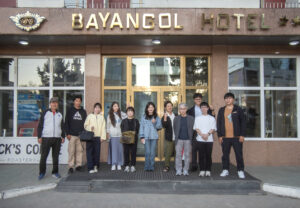
The second day in the morning in front of Bayangol Hotel,Ulaanbaatar
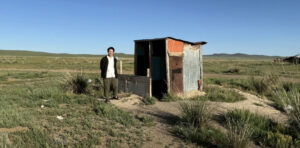
W.C in the field
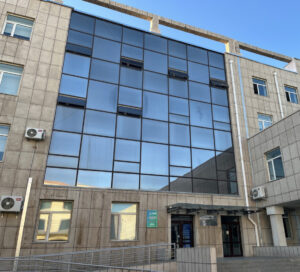
Umnugovi Regional Medical Center
Members
Leader: Dr. Masamichi Tamura (Akita Red Cross Blood Center, Board Member of Heart Saving Project)
Dr. Masahiro Mori (Osaka Women’s and Children’s Hospital)
Dr. Shunsuke Nukaga (Niigata University Medical & Dental Hospital)
Dr. Sonoko Hattori (Akita University Hospital)
Nurse Tomoko Taniguchi (Sapporo Medical University Hospital, Board Member of Heart Saving Project)
From Mongolia: Dr. Bolor (Department of Pediatric Cardiology, NCMCH), one driver, and three members from the local NGO – Ulka, Khurelbold, and Michelle.
Results
Total screened over 3 days: 164 patients
Day 1: 68
Day 2: 94
Day 3: 2
Findings:
No abnormalities: 112
Diagnosed with cardiac disease: 52
Referrals:
To NCMCH: 26
To Songot Hospital: 3 (follow-up)
To Third State Central Hospital: 8 (surgical intervention required)
To local hospital follow-up: 15
Activity Details
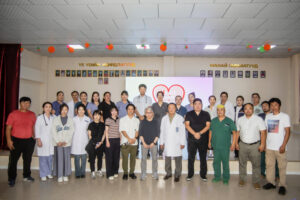
A large number of hospital staff were waiting
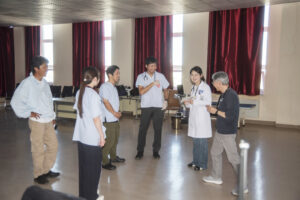
We requested a larger room, they let us use the auditorium
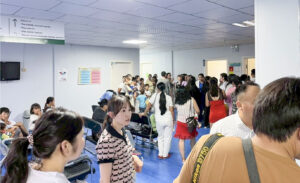
There were many patients and their families in the lobby

Reception desk set up near the entrance
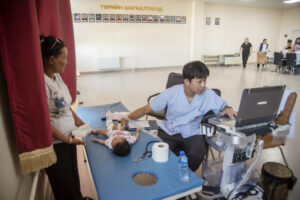
Echocardiography started at three locations
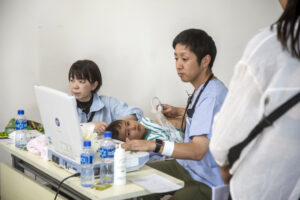
Dr. Nukaga (center), participating for the first time
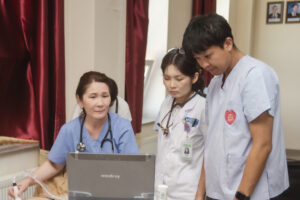
A local adult cardiologist (left), Dr. Bolor from NSMCH(center) and Dr. Mori (left)
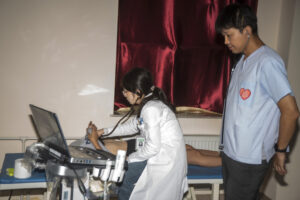
Dr. Mori supervising Dr. Borol of NCMCH

Accommodation is in a tourist ger
August 7 – Arrival
After arriving in Mongolia, we checked into the Bayangol Hotel and had dinner before resting for the day.
August 8 – First Day of Screening
We departed the hotel at 6 a.m. in two cars and drove approximately 550 km, taking about 8 hours. After a short break near a steppe hut with a simple toilet, we arrived in Dalanzadgad around 2 p.m. After lunch, we began screening at 3 p.m.
Sharav Memorial Umnugovi Regional Medical Center is a four-story building with several annexes on a spacious site. The hospital employs four pediatricians and two adult cardiologists. Compared with other provincial hospitals, it is notably well-equipped, reportedly because the region is financially supported by its gold mining industry.
Although several consultation rooms had been prepared for us, we requested one large room, as this facilitated discussion among the physicians, teaching opportunities with Mongolian doctors, and efficient teamwork. We set up three echocardiography machines and began screening at 3:30 p.m., finishing at 6:30 p.m.One of the participating local cardiologists had just completed a one-month training in pediatric echocardiography at NCMCH in May and actively asked many questions. Dr. Bolor from NCMCH, a newly assigned young physician who had never previously performed echocardiography at NCMCH, was very enthusiastic and eager to learn throughout the mission. On this day, we examined 68 patients. Lodging was in traditional tourist gers, adding to the local atmosphere.
August 9 – Full Day of Screening
We enjoyed sunrise over the steppe before beginning a full day of work. Screening took place from 9 a.m. to 5 p.m., and 94 patients were examined. Afterward, we visited the Umnugovi Provincial Museum, which houses dinosaur fossils, eggs, and archaeological traces of human settlement dating back to the Stone Age.
August 10 – Final Day of Screening
Two patients were screened between 9 and 10 a.m., followed by a joint conference with all participating doctors, including those from NCMCH. After lunch, we began the return journey, stopping at Bayanzag (“Flaming Cliffs”), a dramatic red sandstone formation featured in the Japanese TV drama VIVANT. The scenery was reminiscent of the Grand Canyon. After an 8-hour drive, we reached Ulaanbaatar at 9 p.m. and concluded the day with dinner.
August 11 – Departure
We checked out of Bayangol Hotel early in the morning and departed on the 7:45 a.m. MIAT flight, arriving at Narita at 1:40 p.m. The team disbanded at the airport.
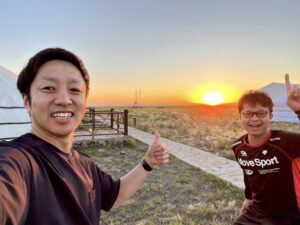
Wonderful sunrise
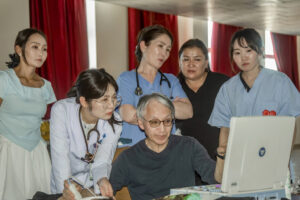
Dr. Bolor (in white coat), doctors from the local hospital (the two in the center of the back row), and Dr. Hattori (on the right), who is participating for the first time, are intently looking at Dr. Tamura’s echocardiogram. On the far left is the patient’s mother.
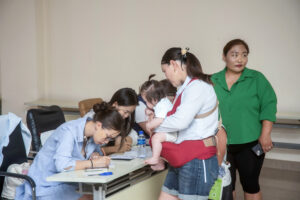
A local NPO will be in charge of reception

The three-day screening acitivity was successfully completed.
Summary
Extending the stay to two nights and three days allowed us to provide meaningful instruction to local physicians and the NCMCH doctor. Previously, Japanese doctors performed nearly all of the echocardiography themselves due to time constraints. This year, with more time, Mongolian doctors were able to perform scans under supervision, receiving hands-on training. A structured conference at the end further reinforced the learning process. We intend to continue maximizing opportunities for local doctors to conduct echocardiography themselves.
Points for Improvement
-
Patient forms: Suggested adding fields for “chief complaint” and “follow-up institution.” Standardization of recording is also recommended for new team members.
-
Patient/family education: Preparing leaflets on common conditions (VSD, ASD, PDA) would be beneficial. It was suggested to confirm whether NCMCH has existing materials that can be used or adapted.
-
Recording echocardiography videos: Capturing video of important cases would improve information sharing.
Room requests: Noting in advance that a large room is preferred would save time and facilitate teamwork.
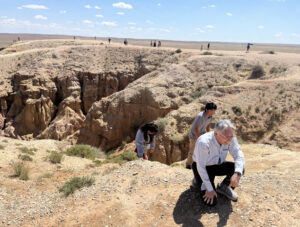
On the way back, we stopped at a tourist spot with a distinctive red earth

Thank you everyone for your hard work
Reflections
Mongolian physicians are increasingly taking the lead in performing echocardiographic examinations. This has fostered stronger communication between Japanese and Mongolian doctors, creating a positive atmosphere and boosting motivation. Japanese participants experiencing the regional screening for the first time reported that the mission provided invaluable experiences for their professional development.
We sincerely thank all those who participated in and supported this mission.
